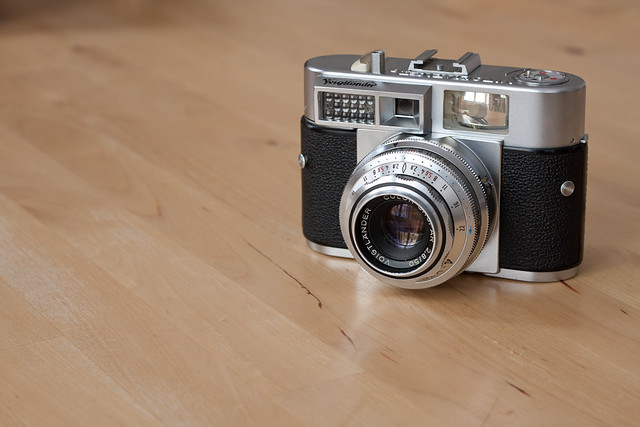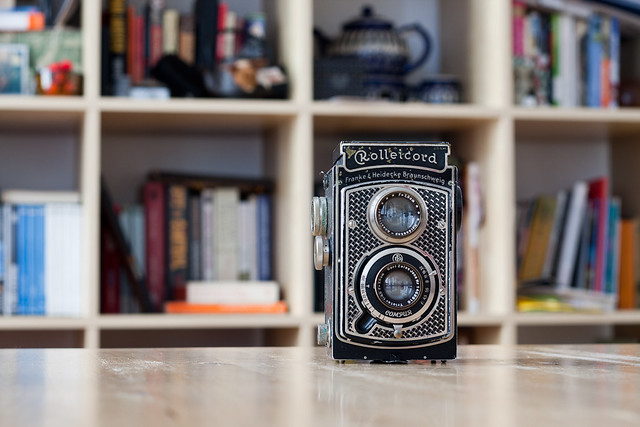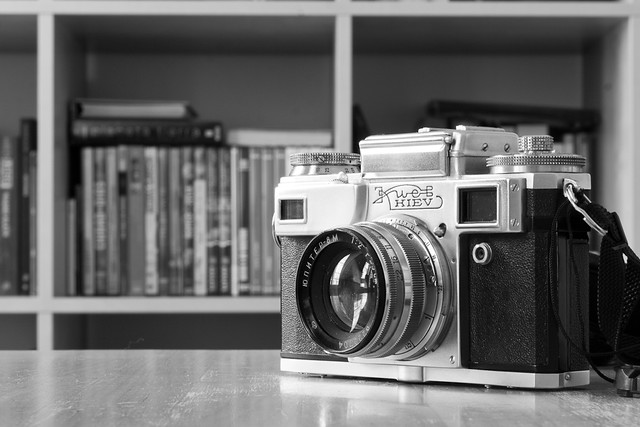I enjoy taking pictures with old cameras, marvel at their ingenious designs and elegant shapes and never cease to be amazed by the optical quality they are capable of delivering even though many of them are well past the 80-year-old mark. This enjoyment has a consequence: I research and read a lot about cameras, the history of camera makers and the lives and achievements of the key persons that brought camera and optical design to the point where it is now. And this consequence has a side effect: For many of the cameras I read about (and that I do not own), I develop great curiosity about how they feel like in the hand, how it is to operate them, what kind of pictures they are capable of rendering.
Out of this curiosity, and also for the sheer enjoyment of looking at pictures of vintage cameras, I use to scout vintage camera listings on eBay, online and offline camera dealers and other platforms where people sell stuff. It is usually a void exercise, since I rarely buy anything, but it helps develop a sense for the sale prices of many cameras and related photographic gear. And, every once in a while, a listing pops up where the price asked is only a fraction of the true value of the article.
One of the standard scenarios for such a bargain to be found happens when the seller, typically knowing very little about vintage cameras, finds herself with a camera in her hands, usually left by someone else (typically a parent, grandparent or friend) and does not know what to do with it. Old cameras tend to be regarded as useless paperweight by many people, especially if their condition is not very good. Since the advent of digital photography, even a 35mm camera (for which film is easily available) is seen as something obscure and obsolete, with little chance to be used again.

I have been lucky (or watchful) enough to have scored a number of such bargains. The first one was my Voigtländer Vitomatic IIa. The seller found it in a closet. It belonged to her grandfather and she had no idea how it worked (in fact, the ad described it as a single lens reflex camera). She was sure that it had rested there for the last twenty years. Complete with its leather case, first it did cost 15€. I silently watched the listing for a couple of weeks, after which the seller cut the price down to 10€. This was an offer I could not ignore anymore. I really wanted to have another Vitomatic, even more one with a rangefinder, and this one was being sold for approximately one eighth of the price indicated by reputable sources. Upon camera arrival, sure enough, the slow speeds did not work properly, but this is a repair that I think I will be able to manage. In the meantime I can live quite comfortably shooting over 1/25. And, of course, in case I botched the repair, not much (economically) would have been lost.

In a similar way I got a Voigtländer Bessa 6x9 medium format folder, a Rolleicord I Art Deco 6x6 twin lens reflex, a Kiev 4 35mm rangefinder, a subminiature Minox B and a Zeiss Ikon Contaflex IV leaf-shuttered single lens reflex, all well under one fifth of the collector's price. I already exposed many films with them. The Kiev might, in fact, be the one I'm going to use the most in this 2014, because I really love using it and the way it feels in my hands.


But perhaps the most spectacular camera deal, and the one that made me think about writing this post, has been a 1929 Rolleiflex Original 611, the first mass marketed twin lens reflex camera, the one that started the Rolleiflex legend and the long TLR golden age. Every TLR model that was to be built in the following 60 years, and there were hundreds of them, was basically an Original Rolleiflex in disguise.

I paid 30€ for this Rolleiflex. Collector prices start at around 300€ for a moderately battered exemplar, because of their historical significance and also because not many of them were built. The seller, a soft-spoken elderly gentleman living in the outskirts of Vienna, got it from the estate of a recently deceased acquaintance. He was genuinely fascinated by the fact that I planned to put this camera into use. The camera came with the original leather case, lens caps, lens hood and yellow filter. I could sense the loveliness and care of the original owner in the way how the yellow filter was protected by a cloth wrapped inside the lens hood, all neatly stuffed in a leather pouch attached to the camera case. This camera was used and loved for a long time. Although it is the early model (the detachable non-hinged back reveals it), a focusing knob with distance scale from the later model replaced the original one. The flash synchronization contact (on the upper right of the front standard) was obviously a much later upgrade.
The shutter, as usual, is a little reluctant on the slower speeds, and one of the brackets supporting the viewfinder hood needs minor fixing. All in all, nothing that scares me or makes the camera unusable. Glass and mirror are clean and film transport works smoothly. The seller was very happy to see that I was going to use the camera ("Sie wollen damit wirklich fotografieren!", "You really want to take pictures with it!", he kept saying). He was happy with the money he got, and I was happy with the price I paid. In fact, on my way back home I could not believe my luck.
And yet, on the next days and weeks I started thinking about how the seller could have easily got at least 200-250€ for this camera, had he brought it to any of the specialized vintage camera dealers in Vienna. He obviously did not know that, he did not know the real value of the Rolleiflex, and I did. And somehow, I began to feel bad, I began thinking if it had not been dishonest of me to pay him just the amount he asked out of ignorance. Would it have been better to tell him: "Look, here's 200€, which is much closer to what this camera is really worth"? And yet, he was happy and I was happy. Is it not the definition of a win-win situation?
This thought comes to my mind every time I find such a deal. The honest collector's dilemma. Be honest and teach sellers about the true value of a camera? Or keep the knowledge to yourself and obtain valuable cameras at a fraction of their price? What do you think?